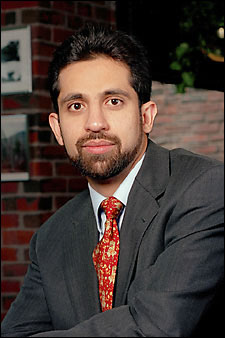Pakistan madrassas less popular than thought
Kennedy School professor says religious school enrollment fairly low
New research is calling into question the prevalence and increasing popularity of religious schooling in Pakistan, with survey data that show previous estimates of enrollment in Islamic madrassas to be far lower than widely reported.
The work, co-authored by Assistant Professor of Public Policy Asim Ijaz Khwaja, draws on public data sources, including the Pakistani national census, to show that madrassa attendance accounts for less than 1 percent of school enrollment, with no evidence of a dramatic increase in recent years. Instead, the dramatic change has been the rise of affordable and mainstream private schools, particularly in rural areas.

The research, available as a working paper on the John F. Kennedy School of Government Web site, said that sources as diverse as the Washington Post, the 9/11 Commission Report, and the private, nonprofit International Crisis Group have cited a large and increasing enrollment of Pakistani children in religious schools.
Figures cited in those sources put enrollment in religious schools as high as 1.7 million, which the nonprofit International Crisis Group said in 2002 was 33 percent of all Pakistani schoolchildren.
Attention was focused on madrassas after the 9/11 terrorist attacks fanned fears of rapidly spreading Islamic fundamentalism, thought to be fed by widespread and increasing enrollment in the religious schools.
For the past two years, Khwaja has been part of a team of researchers conducting a World Bank-financed study of education in Pakistan to determine the educational choices made by Pakistani parents and learning achievement in schools, particularly the rapidly growing private schools. As they conducted their work with detailed surveys and tests of schools, children and households – including a census of over 90,000 households in more than 100 Pakistani villages – Khwaja said they repeatedly came across accounts of the rise of madrassa enrollment that didn’t reflect what they were seeing on the ground.
“We just never thought about madrassas as a major factor, because it never came up [in the surveys],” said Khwaja, who is at Yale University on leave this spring. “It wasn’t in sync with what we were seeing.”
Thinking that perhaps the madrassa phenomena was reflected in educational practices outside of their study area, Khwaja and colleagues looked for publicly available nationwide educational data. They relied on the 1998 national census and the 1991, 1998, and 2001 Pakistan Integrated Household Survey, which asks about schooling choices.
The data showed that roughly 200,000 children were enrolled in madrassas before 2001 and, though there may have been some growth, it has not been dramatic. By way of comparison, there were 17.4 million students in public and private schools in 2003.
Overall, these sources showed enrollment in madrassas to be 0.3 percent of children age 5 to 19. With just 42 percent of children in school, that represents less than 0.7 percent of the school population, far below the 33 percent cited before.
Khwaja said the group’s aim was to get the facts about enrollment straight. Whether madrassa education is good or bad is a different question and requires a different set of data, he said.
“We’re just playing the role of statisticians,” Khwaja said. “Let’s first get the facts straight and then we can have the next conversation.”
The group’s research showed that madrassa enrollment was not entirely uniform across the country, but that even in the regions bordering on Afghanistan, where madrassa enrollment was highest, it was less than 7.5 percent of enrolled children.
The most surprising result, Khwaja said, was the distribution of religious schooling within families. One might think that attendance at a religious school was a reflection of a family’s religious beliefs or available educational options and that families who put a high value on religion or who had no other schooling options would send all their children to a madrassa.
Instead, Khwaja and colleagues found that only 25 percent of families with multiple children and at least one child in a madrassa sent all their children to the madrassa.
“That’s something that really surprised us, that families would send just one child,” Khwaja said. “That was eye-opening.”
The fact that three-quarters of parents with one child in a madrassa send their other children to a public or mainstream private school for their education indicates that other factors are at work that researchers don’t yet understand.
“If anyone is interested in studying this 1 percent [attending madrassas], then they have to account for the differences within families,” Khwaja said.




